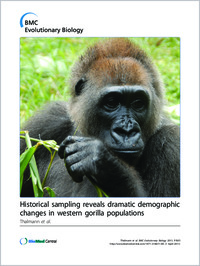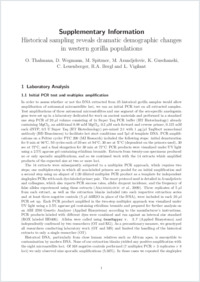Historical sampling reveals dramatic demographic changes in western gorilla populations
- Thalmann, Olaf Max Planck Institute for Evolutionary Anthropology, Leipzig, Germany - Division of Genetics and Physiology, Department of Biology, University of Turku, Finland
- Wegmann, Daniel Dept. of Ecology and Evolutionary Biology, University of California Los Angeles, USA
- Spitzner, Marie Max Planck Institute for Evolutionary Anthropology, Leipzig, Germany
- Arandjelovic, Mimi Max Planck Institute for Evolutionary Anthropology, Leipzig, Germany
- Guschanski, Katerina Max Planck Institute for Evolutionary Anthropology, Leipzig, Germany
- Leuenberger, Christoph Département de mathématiques, Université de Fribourg, Switzerland
- Bergl, Richard A North Carolina Zoological Park, Asheboro NC, USA
- Vigilant, Linda Max Planck Institute for Evolutionary Anthropology, Leipzig, Germany
-
01.04.2011
Published in:
- BMC Evolutionary Biology. - 2011, vol. 11, p. 85
English
Background: Today many large mammals live in small, fragmented populations, but it is often unclear whether this subdivision is the result of long-term or recent events. Demographic modeling using genetic data can estimate changes in long-term population sizes while temporal sampling provides a way to compare genetic variation present today with that sampled in the past. In order to better understand the dynamics associated with the divergences of great ape populations, these analytical approaches were applied to western gorillas (Gorilla gorilla) and in particular to the isolated and Critically Endangered Cross River gorilla subspecies (G. g. diehli).Results: We used microsatellite genotypes from museum specimens and contemporary samples of Cross River gorillas to infer both the long-term and recent population history. We find that Cross River gorillas diverged from the ancestral western gorilla population ~17,800 years ago (95% HDI: 760, 63,245 years). However, gene flow ceased only ~420 years ago (95% HDI: 200, 16,256 years), followed by a bottleneck beginning ~320 years ago (95% HDI: 200, 2,825 years) that caused a 60-fold decrease in the effective population size of Cross River gorillas. Direct comparison of heterozygosity estimates from museum and contemporary samples suggests a loss of genetic variation over the last 100 years.Conclusions: The composite history of western gorillas could plausibly be explained by climatic oscillations inducing environmental changes in western equatorial Africa that would have allowed gorilla populations to expand over time but ultimately isolate the Cross River gorillas, which thereafter exhibited a dramatic population size reduction. The recent decrease in the Cross River population is accordingly most likely attributable to increasing anthropogenic pressure over the last several hundred years. Isolation of diverging populations with prolonged concomitant gene flow, but not secondary admixture, appears to be a typical characteristic of the population histories of African great apes, including gorillas, chimpanzees and bonobos.
- Faculty
- Faculté des sciences et de médecine
- Department
- Département de Mathématiques, Département de Biologie
- Language
-
- English
- Classification
- Biological sciences
- License
- License undefined
- Identifiers
-
- RERO DOC 22786
- DOI 10.1186/1471-2148-11-85
- Persistent URL
- https://folia.unifr.ch/unifr/documents/301849
Other files
Statistics
Document views: 86
File downloads:
- leu_hsr.pdf: 159
- leu_hsr_sm.pdf: 154

